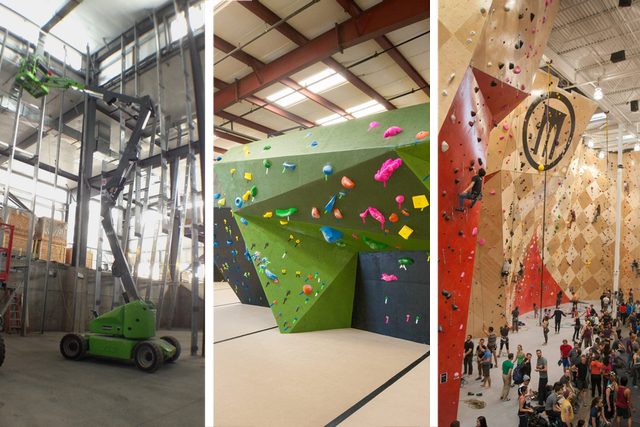
The rate of new climbing gyms entering the US market took a modest dip compared to last year, ending with a 9% annual growth rate, versus 10% in 2013. The rate is lower than expected due to several projects that were planning to open this year experiencing construction delays and funding issues that resulted in their opening dates getting bumped into 2015. Earlier this year CBJ had predicted a rate closer to 11%, but once the dust settled on 2014 we have confirmed 29 new gyms, plus 3 gyms that moved to new facilities, for a total of 353 commercial climbing facilities in the US.
Despite the slight downturn, climbing gym developers are still bullish and are continuing to build new facilities and expand existing gyms. California was the big winner with five new climbing gyms, all of which are located in the red hot SoCal market. Hangar 18 opened a new traditional and a new bouldering gym, and also purchased Threshold Climbing, taking the Hangar brand up to a total of 8 facilities.
Other notable openings around the country include California-based, Planet Granite’s first out-of-state expansion to Portland, Oregon; their smartly-designed urban facility has some industry insiders calling it the next-generation of climbing gyms. Perhaps the most influential climbing gym in America, Movement Climbing and Fitness, opened their much anticipated second location in Denver, Colorado. The facility copies most of the innovative, and much emulated, designs of their Boulder, CO facility, but on a bigger and more impressive scale. Stone Summit continues to set the standard for gigantic facilities with their new Kennesaw location. The owners, Darin Pair and Daniel Luke, learned a few lessons from their Atlanta facility and have designed their new gym to be more accessible to climbers of all abilities.
It was Salt Lake-based Momentum Climbing that surged through 2014 by opening the doors on two locations; one traditional gym in Millcreek, Utah and a Font-inspired bouldering gym in Lehi, Utah. These new facilities took Momentum from one location to three, making them the fastest growing climbing gym company in the US.
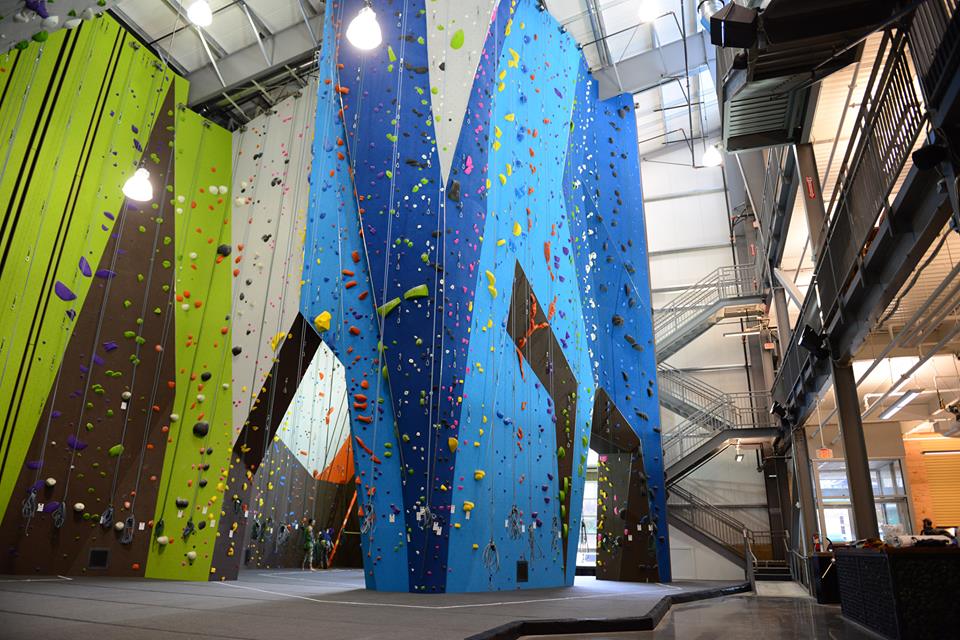
| NEW TRADITIONAL GYMS of 2014 | ||
|---|---|---|
| Stronghold | Los Angeles | CA |
| Movement – Denver | Denver | CO |
| Grand Valley Climbing | Grand Junction | CO |
| Stone Summit – Kennesaw | Kennesaw | GA |
| Treadstone | Columbus | GA |
| BKB Chicago | Chicago | IL |
| Vertical Endeavors – Glendale Heights | Chicago | IL |
| North County Climbing Center | Lisbon | NH |
| Gravity Vault – Middletown | Middletown | NJ |
| Vertical Adventures – VA513 | Columbus | OH |
| Climb UP | Norman | OK |
| Planet Granite – Portland | Portland | OR |
| Momentum Indoor Climbing – Millcreek | Millcreek | UT |
| MetroRock – Burlington | Essex Junction | VT |
| Climbing New Heights | Martinsburg | WV |
Bouldering Gyms
Bouldering gyms continue to play a major role in the climbing industry. Out of the 29 new gyms that opened this year, 14 were bouldering-only facilities. That’s a 15% growth over last year. This growth is attributed to, in one sense, large developers spreading their brand into urban areas that have existing competition. In addition to Momentum’s and Hangar 18’s bouldering facilities mentioned above, Central Rock brought a bouldering-only facility to Cambridge, a trendy scene with high lease rates, but with advantageous demographics. (Rock Spot is also expecting to open a bouldering facility in South Boston the first week of January, 2015).

First-time owners also played an important role in the bouldering gym scene. Six bouldering gyms were opened by first-time operators, including Kinetic Bouldering in Columbus, Ohio, The Grotto in San Diego and The Wall in Vista, California. With an emphasis on well-thought-out design, designated space for social activities and robust fitness areas, these gyms are able to bring all the best aspects of climbing to a low-cost business model.
Small was also the name of the game for bouldering gyms. Nine bouldering gyms with less than 7,500 square feet of climbing surface were opened across the country. This trend, and bouldering gyms in general, emphasizes the market differentiation that the climbing industry is experiencing. From large corporate run facilities to tiny shoestring walls, the industry is beginning to stratify which allows more entrepreneurs to get in business, and for more climbers to experience the joy of climbing.
| NEW BOULDERING GYMS of 2014 | ||
|---|---|---|
| Hanger 18 – Rancho Cucamonga | Rancho Cucamonga | CA |
| Hangar 18 – San Clemente | San Clemente | CA |
| Grotto Climbing | San Diego | CA |
| The Wall | Vista | CA |
| Denver Bouldering Club- South | Denver | CO |
| Central Rock Gym – Cambridge | Cambridge | MA |
| Progression Climbing | Chapel Hill | NC |
| Taos Rock Gym | Taos | NM |
| Refuge Climbing Center | Las Vegas | NV |
| Steep Rock Bouldering | New York | NY |
| Kinetic | Columbus | OH |
| Circuit Bouldering Gym – Tigard | Tigard | OR |
| Momentum Indoor Climbing – Lehi | Lehi | UT |
| AlpenFit | Park City | UT |
No Rock, Know Gyms
To outsiders it may seem obvious that there would be more indoor climbing gyms in areas with limited outdoor rock climbing. But historically that has not been the case. Most gym development has been in places with accessible rock climbing and a ready-made climbing community. This year we’re starting to see that change.
The Midwest may have limited rock climbing opportunities, but this region of the country is quickly developing a strong indoor scene. Chicago, Illinois welcomed two new gyms from long-time developers. Opening first was the Nicros-built Vertical Endeavors – Glendale Heights facility, which is now the largest climbing gym in the country. Brooklyn Boulders was hot on their tail with their 3rd facility and their first outside of the Northeast. BKB is banking on a new approach to the old rock gym business model by combining the fitness elements a climber wants with the energy of start-up entrepreneurs and the creative spirit of an artist collaborative.
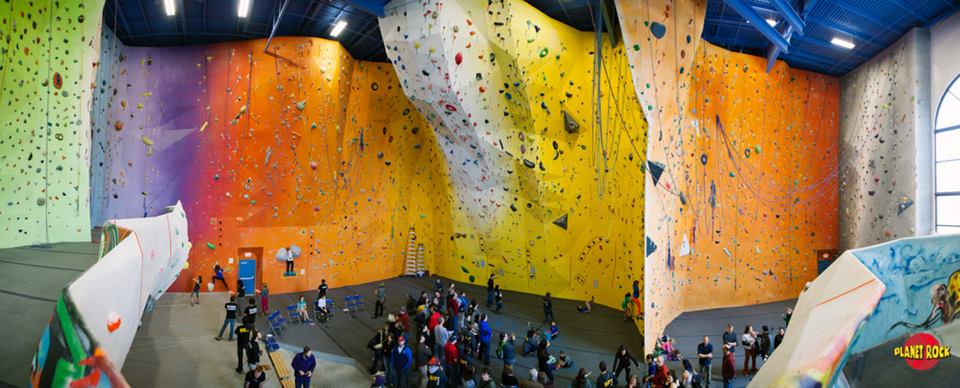
Keeping the dream alive near Detroit, Michigan is Planet Rock, the legendary purveyor of plastic, who built a new 24,500 SF facility in Madison Heights to replace their aging Pontiac gym. No need to call in the big wall manufacturer, these guys kept it local by building the walls themselves and then filling it with their in-house hold company, DRCC. Meanwhile in Columbus, Ohio two new gyms were opened, the aforementioned Kinetic Bouldering and Vertical Adventures, which built a new gym to replace their 20 year old gym a few blocks away. VA has plans to turn their original gym into a dedicated training facility.
South, But Not Texas
Gym development was energetic if not sporadic in the South, with companies such as Climb Nashville, Stone Summit, and Triangle Rock Gym bringing plastic to the masses. Norman Oklahoma even has a beautiful new gym, Climb UP, from the creators of the landmark Rocktown silos in Oklahoma City.
But there’s one major state that is not represented this year: Texas. Texas ranked third in rate of population growth at 5.2% since the last census. A report from the Texas state demographer states that the state’s largest metropolitan areas, including Dallas-Fort Worth, Houston, Austin and San Antonio, saw the greatest population increases. The Texas economy is also booming. In Houston, which is the 10th largest metro area in the US, the economy is experiencing unprecedented growth pegged to the oil and energy sector (here’s a great article breaking down the growth of the Texas economy).
Despite this growth, no new commercial climbing gyms open in the Lone Star state in 2014.
Why such slow movement in Texas when all signs point to success for a enterprising developer? Most gym insiders site real estate prices, obesity rates, culture and a shortage of outdoor/fitness enthusiasts. In Houston, the obesity rate was 66% of adults in 2009, and the area earned the unenviable distinction of #1 Fattest City by Mens Health.
San Antonio might be a better choice for a climbing gym. They don’t have a single commercial climbing gym but do have 1.4 million people that are getting leaner. The San Antonio Metropolitan Health District (Metro Health) announced that the obesity rate in San Antonio plunged from 35.1% to 28.5% between 2010 and 2012.
“People are getting more active and living healthier in San Antonio, whether it’s walking, cycling or using our parks,” Mayor Julián Castro said. “We now have concrete evidence that our investments are paying off and positively impacting the health of our families and the overall quality of life in San Antonio.”
You might be asking, What about Austin? Yes Austin, that liberal bubble in Central Texas with rock climbing right in the middle of town. As CBJ wrote earlier this year, Austin is expecting two new gyms, now slated to open in 2015.
Few Closings
Shuttered gyms are a rarity in the climbing industry, and this held true in 2014. Only two commercial climbing gyms shut their doors, including Enclosure Climbing in Jackson Hole, Wyoming which had a very public closing after a failed effort to sell the business.
“I was devastated,” Heemstra, a local climber told the Jackson Hole News & Guide. “This has been a huge part of my life the last eight years. As a climber here in Jackson you really need an indoor facility if you’re going to climb because you need to keep your head in the game. At least for me, having an indoor facility when I can’t climb outdoors nine months out of the year is critical.”
But local climbers still want a place to climb so a group has started the process to bring climbing back to Jackson. According to another article in the Jackson Hole News & Guide, a trio of climbers has proposed building an indoor climbing facility on public land next to the Teton County/Jackson Recreation Center. Taking the proposal from dream to reality would cost around $1.2 million according to current estimates. The plan is for a gym of about 8,000 square feet.
Rockreation – Salt Lake City, which opened in 1993, also closed their doors this year. According to owner Jeff Clapp, they elected to shut down operations in anticipation of direct competition from Momentum’s new Millcreek facility and the upcoming expansion of The Front. “After a lot of soul searching,” Clapp wrote in a statement, “I have come to the hard reality that the Rockreation Salt Lake City gym is no longer able to compete in today’s state-of-the-art indoor climbing world.”
Jeff Clapp is not one to sit around and ponder the past. He and his wife opened the 10,000 SF Refuge Bouldering gym in Las Vegas, Nevada earlier this year, bringing the first new commercial climbing facility to the city in nearly 20 years.
Real Estate
For gym developers, real estate acquisition is still a major deterrent to growth. Because of the unique needs of a modern climbing gym, including a large clear-span and high roof height, owners are finding it difficult to find buildings that meet their needs. When you add in significant parking requirements, zoning, height limitations and freeway access, the property search starts looking grim.
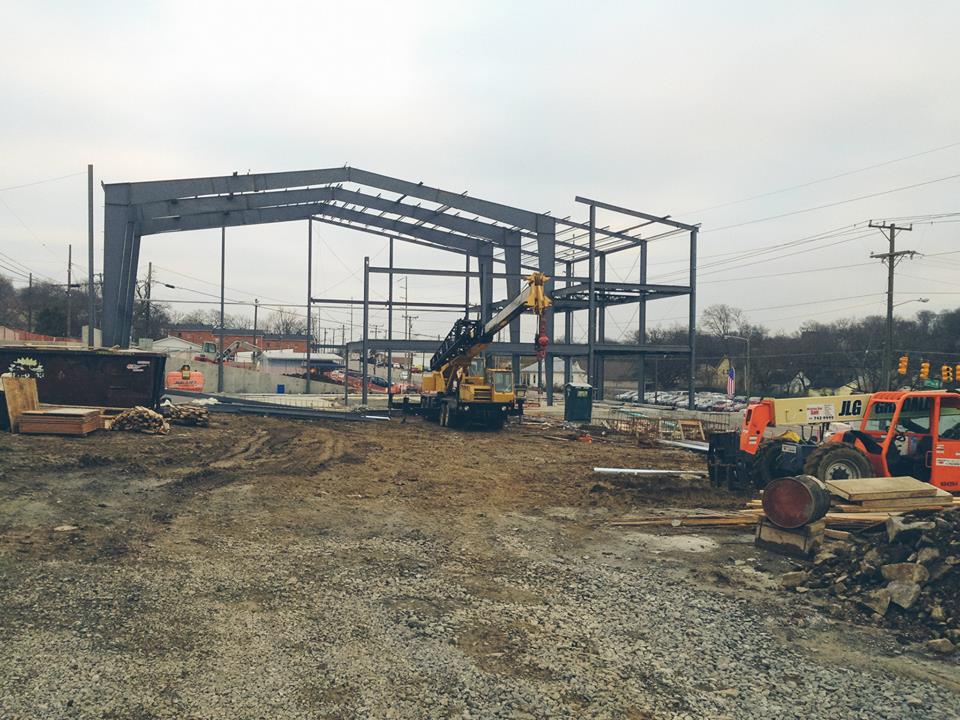
The common practice of popping the roof on existing buildings to achieve the desired height is still a reliable method of turning old warehouse, industrial or retail spaces into climbing facilities. The new Brooklyn Boulders – Chicago and Momentum – Millcreek are prime examples of this. However, many gym owners are unsatisfied with the current supply of real estate and they are finding it hard to find amenable landlords that will allow such heavy building modification.
That’s why, now more than ever, developers are looking to build facilities from the ground-up. Nine of the 32 new facilities that were built this year found bare land or scraped the property to start fresh with a purpose-built structure. Gyms like Movement – Denver, Stone Summit – Kennesaw, Grand Valley Climbing and L’Escalade in Lexington, KY all went ground up after not finding any suitable properties.
For the foreseeable future, building ground-up will be reserved for those enterprises that can afford the added cost of acquiring land and contructing a building. Doing so adds $1m – $4m to start-up budgets. While not surprising, it should be noted that as far as our research has shown no bouldering-only facility has gone ground-up in the US.
The Builders
Of the 32 new commercial climbing walls built this year, Walltopia landed the most contracts and put up the most climbing surface. Their 2014 tally came to nine facilities for a total of 168,538 SF of climbing surface, making them the top builder of the year. Nicros was at the bottom of the list with one project, but it happens to be the biggest in the country at 45,000 SF, which places them second in terms of square footage. Likewise, Rockwerx placed in the middle of the pack in number of projects, but took third in footage with 40,000 SF of wall across 3 projects. Louie Anderson & Associates quadrupled their output over last year by building four new facilities, all bouldering-only, for a total of 26,000 SF of climbing.
The major wall manufactures are still up against stiff competition from self-built or General Contractor-built climbing walls. CBJ compiles this group as “Owner Built”, which amounted to a total of nine gyms, equal to Walltopia’s project tally.
Looking Forward
With this year’s slightly lower growth rate, 2014 may, in retrospect, be the year the industry took a moment for a deep breath before sprinting into next year. Gym operators have already announced plans to open more than 40 new gyms in 2015, and if all of them open CBJ expects the annual growth rate to exceed 12% next year.
One major trend taking shape is the number of gyms opening locations outside of their home state, and even outside their home region. Earth Treks kicked off this trend last year with their leap from Maryland to Colorado. This year Metro Rock jumped across state lines from Massachusetts to Vermont, Vertical Endeavors leap-frogged from Minnesota with their first stand-alone facility in Illinois and Planet Granite skipped up the coast from California to Oregon. BKB made the farthest vault from New York to Illinois. Expect more gyms to follow suit as successful businesses outgrow their home market, but not their desire for growth.
This year we saw multiple gyms forgo upgrading older facilities in favor of building a brand new gym not far away from their original location. Climb Nashville, Planet Rock Gym and Stone Age all built, from the ground-up, new gyms to replace their one or two decades old locations.
Another trend emerging is the growth of dedicated training areas within climbing facilities. Historically, adding a system or campus board to the gym was a major hurdle. Now it is becoming common to see up to three articulating training walls, massive campus boards, multiple hangboards and serious rigs for rings, balls and bombs. Momentum’s new Millcreek and Lehi locations are a prime example of what we might expect to see more of in 2015.
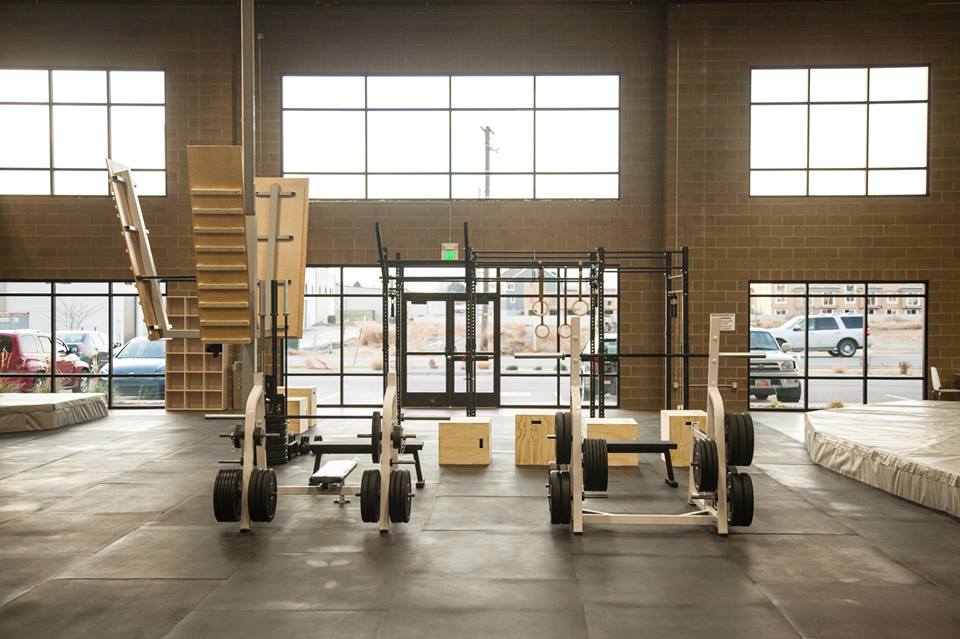
From what CBJ is hearing from wall manufactures we anticipate fewer dedicated speed climbing walls even as speed climbing becomes more popular. As route setting gains importance from operators we’ll see less space dedicated to fiberglass walls and features, and much more use of volumes. Part of this trend is that wall builders are bringing products to market, such as Rockwerx’s Gym Rock Lite and Eldo’s USA Wall, that meet the demands for flatter walls that easily accept screw-on volumes and provide a smoother surface area for large bolt-on climbing holds.
In the end, 2014 has been a good year for the climbing industry. Even though we didn’t see the same growth as last year, 9% is still a healthy rate, and perhaps more importantly, the major players and the first-time owners all stepped up their game by providing better and more professional services to their members. CBJ is excited for what 2015 will bring!

Climbing Business Journal is an independent news outlet dedicated to covering the indoor climbing industry. Here you will find the latest coverage of climbing industry news, gym developments, industry best practices, risk management, climbing competitions, youth coaching and routesetting. Have an article idea? CBJ loves to hear from readers like you!






